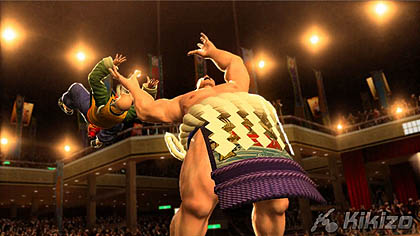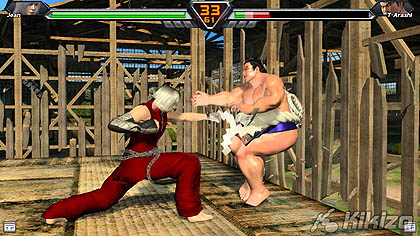Virtua Fighter 5 R: The ONLY Interview
Check out our huge, exclusive interview with SEGA AM2 development boss Makoto Osaki to get the full story on Virtua Fighter 5 Revolution, and various other hot topics.
Page 4
Kikizo: There has been a bit of criticism from fans online that some of the items and outfits available for the characters are getting "too ridiculous" and are inappropriate for a game based on serious martial arts combat. How would you respond to this?
Osaki: [laughs loudly] Honestly, we thought like that for a long while, too! But, see, back when VF4 was around, we had these "embarrassing" items that'd get stuck on you for losing too much or generally not performing well. We wondered what the players would think of these items, but what we found was that they were quite well accepted. People were deliberately losing to try and get some of this ridiculous stuff. In the beginning of VF5, we made mostly "natural" items - hair, make-up, things like that. But what seemed to make users the happiest were those big, standout items. We figured, "Hey, people dig this stuff, why not give them more of it?" We really thought putting those sorts of items into the game was "risky" at first, but now they seem to be the "must-have" stuff.
Kikizo: Recently, an item was made available in-game that allows the characters to wear Nendoroid dolls that look like the characters of Hatsune Miku and Kagamine Ren and Len. Is this a hint that there might be more collaborations between Sega and Crypton Future Media and Good Smile Company in the future? (Maybe there will be VF5 character Nendoroid toys made available?!)
Osaki: Unfortunately, I don't think any VF Nendoroid characters are coming at the moment! But... Hmm. Hmmmmmmm! [laughs] But the people who hold the rights to Hatsune Miku and the others - Crypton Future Media - are really, really picky about the products they license the characters out to. If the quality of the products are up to their standards, they'll be happy to let us use her likeness. They're more concerned about the heart of the product than just licensing Miku out to anyone and everyone. [Speaking of which, Sega's just announced a PSP Hatsune Miku game... - Ed]
Kikizo: So why did you decide to collaborate with Crypton specifically and add the Vocaloid characters in as items?
Osaki: We've had talking items in the game for a little while now. The characters - Usagi-san the rabbit, Torasuke the tiger - will sometimes say things after matches. Miku and the others are in a similar vein. As for how we got the license, well... to be honest, I'm a big fan of Miku and the site that made her popular, Nico Nico Douga [a Japan-centric movie sharing site]. So when the Sega licensing department was asking the dev teams about whether we were interested in using the Miku character. I basically raised my hand and said "YES, PLEASE!" [laughs] So the Vocaloid characters are officially the third "talking" items in the game.
Kikizo: Fighting games aren't as popular as they were about a decade ago. Some have argued that fighting games are simply becoming too complex and uninviting to new and casual players. Do you agree with this? What can we do, as genre fans and game developers, to bring more new players and fans to fighting games? What are your thoughts on popular console-based, "casual" fighting games like Dairantou Smash Brothers X?
Osaki: I definitely agree. Actually, when the VF series first appeared on the scene, it was a 3-button game in a time where Capcom's 6-button fighters ruled the scene. It seemed like a pretty simple game in comparison at the time. But over the course of the next 15 years, VF became more and more complex by leaps and bounds. I wonder - if series creator Yu Suzuki were to try and develop a fighting game now, what kind of game would it turn out to be in the current environment? Maybe something with a different input method. We've done other experiments with alternative forms of input in the past, like in AM3's 1994 Dragonball arcade game that used a camera to detect player motions.
Kikizo: Well, it's interesting that you say that, because Yu Suzuki's touch-screen fighter, Psy-Phi, was cancelled in 2006 after location testing. Those kinds of games with alternative input methods seem more successful in the home market, though. You've got the EyeToy and Wii games...
Osaki: Frankly, though, the traditional arcade game format - with joysticks and buttons - is by far the cheapest for retailers. In the past, we released a lot of games with gimmicks like motion chairs like Space Harrier and OutRun. You rarely see those kinds of games in arcades anymore because of the cost. Arcade managers simply can't afford that sort of investment. And let's not even go into the overseas market... it's practically dead. The market there is entirely redemption [prize] machines now. The users in America just don't go to arcades anymore, because they don't see why they should invest the effort when they have games at home. In Japan, you've got arcades near train and bus stations that the vast majority of the people have to pass going to and from work, so they get a lot of traffic.
So now you've got a smaller market. In the past, we'd get a good return on investment if we budgeted a lot towards the development and manufacture of those sorts of "gimmick" machines. But when you've got a smaller market, you can't afford to give those sorts of games as big a budget, and so you see far fewer of them make it into production. That's why it's so hard to get those sorts of alternative-input machines onto the market.
Ah, wait, we got sidetracked! I almost forgot about the last part of your question. About Smash Brothers... I like the game, and my son plays it a lot. It feels a lot more like a genre-ambiguous title. The timing of input in the game, from my impressions, doesn't seem quite as strict, and the base gameplay is easier to pick up than traditional fighting games. I have to wonder though, if it'd be as successful if the game featured all original characters instead of the established Nintendo cast... I don't think it'd do well at all in that case.













 Satoru Iwata Video Interview - the late Nintendo president spoke with Kikizo in 2004 as 'Nintendo Revolution' loomed.
Satoru Iwata Video Interview - the late Nintendo president spoke with Kikizo in 2004 as 'Nintendo Revolution' loomed. Kaz Hirai Video Interview - the first of Kikizo's interviews with the man who went on to become global head of Sony.
Kaz Hirai Video Interview - the first of Kikizo's interviews with the man who went on to become global head of Sony. Ed Fries Video Interview - one of Xbox's founders discusses an epic journey from Excel to Xbox.
Ed Fries Video Interview - one of Xbox's founders discusses an epic journey from Excel to Xbox. Yu Suzuki, the Kikizo Interview - we spend time with one of gaming's most revered creators.
Yu Suzuki, the Kikizo Interview - we spend time with one of gaming's most revered creators. Tetris - The Making of an Icon: Alexey Pajitnov and Henk Rogers reveal the fascinating story behind Tetris
Tetris - The Making of an Icon: Alexey Pajitnov and Henk Rogers reveal the fascinating story behind Tetris Rare founders, Chris and Tim Stamper - their only interview? Genuinely 'rare' sit down with founders of the legendary studio.
Rare founders, Chris and Tim Stamper - their only interview? Genuinely 'rare' sit down with founders of the legendary studio. The History of First-Person Shooters - a retrospective, from Maze War to Modern Warfare
The History of First-Person Shooters - a retrospective, from Maze War to Modern Warfare